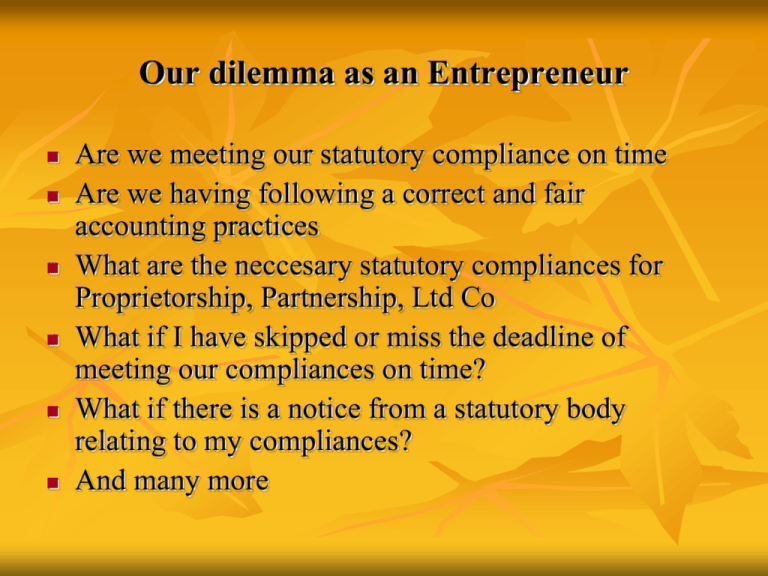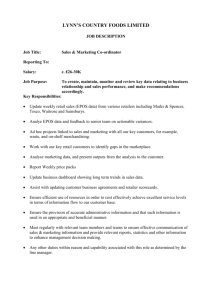Service Tax - finishingschool
advertisement

Our dilemma as an Entrepreneur Are we meeting our statutory compliance on time Are we having following a correct and fair accounting practices What are the neccesary statutory compliances for Proprietorship, Partnership, Ltd Co What if I have skipped or miss the deadline of meeting our compliances on time? What if there is a notice from a statutory body relating to my compliances? And many more Objective Importance of Accounting and Compliance Management Implementing fair and correct Accounting and Compliance Practice Timelines of Statutory Compliance Use of correct method of Accounting Practices Transition phase from Proprietorship to Partnership to Pvt or Pub Ltd Co How can a fair accounting practice increase the valuation of the Company FOREIGN DIRECT INVESTMNT IN RETAIL What Is FDI? FDI or Foreign Investment refers to the net inflows of investment to acquire a lasting management interest (10% or more) in an enterprise operating in an economy other than that of the investor . It usually involves participation in management , joint venture , transfer of technology and expertise. FDI can be used as one measure of growing economic globalization. Indian Retail Sector -FDI In Retailing The key routes that Cos. are taking are: 5 Joint Venture Local manufacturing (such as McDonald’s) Franchising and Licensing Route Sourcing from Small scale sector Cash and carry operations (such as Metro, Shoprite South Africa) SINGLE AND MULTI BRAND RETAIL SINGLE BRAND RETAIL : It implies that a retail store with foreign investment can only sell one brand. Eg. Nokia , Reebok and Adidas. MULTI BRAND RETAIL : Retail store can sell multiple brands under one roof. Global retailers like Wal – Mart , Carrefour and Tesco can open stores offering a wide range of household items and grocery directly to consumers in the same way as the “ Kirana” stores.. PRESENT SHAPE OF FDI Retail industry – Second largest employer ( with an estimated 35 million people engaged by the industry). FDI in multi brand to 51%. New policy will allow multi brand foreign retailers to set up shop only in cities with a population of more than 10 lakhs as per the 2011 census.( there are 53 such cities) Foreign retailers will be required to put up 50% of total FDI in back-end infrastructure excluding that on front end expenditures ( land cost and rent will not be counted ). Big retailers will need to source atleast 30% of manufactured or processed products from small retailers OR MANUFACTURERS . According to the newspaper Indo – Asian News Service , Washington US has said that FDI in retail tradewould be beneficial to both India and U.S. In Jan 2012 SINGLE BRAND FDI hiked to 100 % from 51%. FAVOuRABLES INDIAN FARMERS : Farmers will be the biggest beneficiary of FDI in retail who will be able to improve their productivity. INDIAN CONSUMERS : Indian consumers will get access to quality goods at a low cost, that too at home. PROPER TAX SYSTEM :Tax revenue will increase like VAT and service tax. PARTERNSHIP OPPORTUNITY : Indian Retailers have reason to be happy as it involves a lot of learning that could take them to higher profitability. HIGH AVAILABILITY OF JOBS DISTRIBUTION SYSTEM : 30-35% of India’s total production of fruits and vegetables is wasted every year due to inadequate cold storage and transport facilities. Giant retailers will help India to have strong storage system with highly developed transportation. INDIAN MIDDLE CLASS KNOWLEDGE ENHANCEMENT : FDI in retail will make way for inflow of knowledge from international experts. MANAGEMENT EDUCATIONAL INSTITUTE BOOM : Growth of organized retail in India will be a “ sunrise” for the management educational institute. INFLATION CONTROL :Inflation will be curbed. UN-FAVOURABLES The new system will displace the traditional shops and petty retail shops in markets and mohallahs. Around 38% people in rural areas and around 47% in urban areas depend on retail trade for their livelihood , which will be affected. Around 14 crore people are directly or indirectly earning from the retail sector. So this may in turn render the people engaged there jobless and non business oriented. Proprietorship Singly owned or managed company Mandatory Requirements Pan Card of Proprietor Service Tax Number if providing services covered under service tax TIN number if engaged in trading of goods covered under the Sales Tax Act Current Account with any Bank TAN Number for TDS deduction Statutory Compliance Income Tax Return ( ITR 4 ) Maintenance of Books ( If Tax Audit is compulsory ) Service Tax Return ( if service tax number taken ) Sales Tax Return ( if TIN number taken ) Filing of TDS Return if Tax Deducted at Source Tax Audit – If applicable as per Income Tax Act ( i.e if turnover exceeds the statutory limit) Partner Ship Various Individuals creates a partnership concern Mandatory Requirements Pan Card of Partnership Partnership Deed Service Tax Number if providing services covered under service tax TIN number if engaged in trading of goods covered under the Sales Tax Act Current Account with any Bank – Can have various signatories TAN Number for TDS deduction Statutory Compliance Income Tax Return ( ITR 5 – Partnership concern ) Income Tax Return ( ITR 3 – for individuals who are partners ) Maintenance of Books of Accounts Service Tax Return ( if service tax number taken ) Sales Tax Return ( if TIN number taken ) Filing of TDS Return if Tax Deducted at Source Tax Audit – If applicable as per Income Tax Act ( i.e if turnover Private or Public Ltd Co Various Individuals are Directors or Promoters Privately held or Publicly held shares Mandatory Requirements Registration of Company with ROC Memorandum of Association and Articles of Association Pan of the company. Service Tax Number if providing services covered under service tax TIN number if engaged in trading of goods covered under the Sales Tax Act Current Account with any Bank – Can have various signatories TAN Number for TDS deduction DIN required for all Directors ( ROC purpose ) Digital Signatures required for Director who is authorized signatory Private or Public Ltd Co Statutory Compliance Audit and Tax Audit – If applicable as per Income Tax Act Income Tax Return ( ITR 6 – Partnership concern Maintenance of Books of Accounts Service Tax Return ( if service tax number taken ) Sales Tax Return ( if TIN number taken ) Filing of TDS Return if Tax Deducted at Source Registrar of Companies – Annual Return with ROC form 20B, 66 for compliance certificate, 23AC and ACA Tax Audit – If applicable as per Income Tax Act ( i.e if turnover exceeds the statutory limit) Income Tax Income Tax Site – http://www.incometaxindiaefiling.gov.in Different forms for different concerns ITR 4 – Proprietorship ITR 5 – Partnership ITR 6 – Limited Companies Due Dates st 31 July for whom tax audit is not required. For Individuals/Partnership who requires tax audit u/s 44AB – 30th September For Companies – 30th September Rates of Income Tax Individuals – As per the Tax Slab Partnership and Corporate – 30% of the Profit and Surcharge Tax Deducted at Source Income Tax Site – http://tin-nsdl.com TAN number is compulsory TDS deducted should be deposited on or before 7th of every month (April to February) and TDS deducted in March should be deposited on or before 30th April Different TDS certificates issued for different deductees Form 16 for salaried employees Form 16A for professionals and other deductees Due Dates for filing TDS Returns 1st Quarter April to June – 15th July 2nd Quarter July to Sep – 15th Oct 3rd Quarter Oct – December – 15th Jan th th 4 Quarter Jan – March – 15 May Rates of TDS Depends upon the deductor and deductee and type of transaction Sales Tax TIN Number has to be obtained compulsorily if Sales Tax is applicable i.e once sales transaction is done, covered under the Sales Tax Act. Due date for remittance of VAT and CST returns – for Financial Year 2010 - 2011 – 20th of the following month. Sales Tax need to be deposited monthly/quarterly/annually depending upon the turnover and quantum of Tax Payable. Returns can be filed monthly or quarterly /annually depending upon the turnover and quantum of Tax Payable Service Tax Service tax is mandatory if services provided covered under the service tax. Mandatory for all types of concern Rate of Service Tax 10.3% on the services rendered To apply – ST 1 form is required To file service tax return ST 3 form is required Service Tax Site - http://www.servicetax.gov.in/ Due dates for depositing service tax is Incase of Companies – April to Feb (5th of every following month) and March – 31st March Incase of Non Companies – April to June – 5th July, July to Sep – 5th Oct, Oct – Dec – 5th Jan and Jan – March – 31st March Due date for filing service tax returns – Half yearly – April to Sep – 25th Oct Half yearly – Oct to March – 25th April ROC Management ROC Tax Site – http://www.mca.gov.in DIN number to be obtained for every director of the company To be registered under Companies Act 1956 to attain the status of the company Annual Return and other compliances has to be filed through ROC site Digital signature required for authorized director Due Date of filing the Compliance Certificate/Final Accounts is 31st October and Annual return is 30th November of the subsequent financial year Annual return forms 20B, 23 AC & ACA, Form 66 for compliance certificate Compulsory for all registered companies Filing charges as per the authorized capital and AGM dates Maintenance of Books of Accounts, Books of Minutes of General meeting and Board of Directors Meeting Accounting Management Method of Accounting – Accrual or Receipt Basis ( Cash Basis ) Accounting Standard – ICAI – Indian GAAP – General Accounting and Auditing Practices Types of Accounts – Balance Sheet, Profit and Loss, Cash Flow, Ratio Analysis, Bank Reconciliation, Types of Books – Cash Book, Bank Book, Ledger – Journal Vouching, Debtors and Creditors Types of Vouchers – Cash, Bank, JV U/s 44AA – Compulsory maintenance of books of account if the turn over exceeds Rs 60 lakhs. Accounting Management – Important Figures Balance Sheet – Assets should match the Liabilities Profit and Loss Account - Gross and Net Profit Earnings before Interest, Tax and Depreciation Ratio Analysis – Stock Turnover, Debtors Turnover, Net Profit, Current Ratio etc. Cash Flow and Fund Flow in positive and negative Valuation of the Company. Fair accounting and compliance practice If accounting and compliance practice followed properly and on time you come in good books of the regulatory body Increase in credit worthiness and easy to obtain credit Checks on creditors and debtors – Helps in to reduce the credit period and bad debts Increase in valuation of the company as following correct accounting principals may give correct gross and net profit figures along with other relevant figures. Advantages of converting the Partnership Firm/Proprietorship into Private limited company: Other Advantages Separate legal entity. Perpetual succession Easy transferability of shares Distribution of profits by way of dividends Remuneration to directors. Limited liability of members Raising of capital through Issue of equity/ preference shares and debentures Favourable attitude of financial Institutions while granting various facilities. Precautions Interest on capital cannot be paid. Deposits can be accepted only from Members, Directors and their relatives All legal proceedings by and against the company remain continued even after the conversion.







